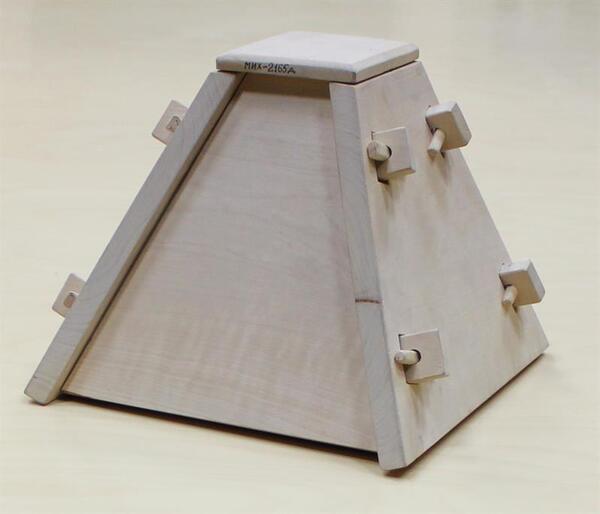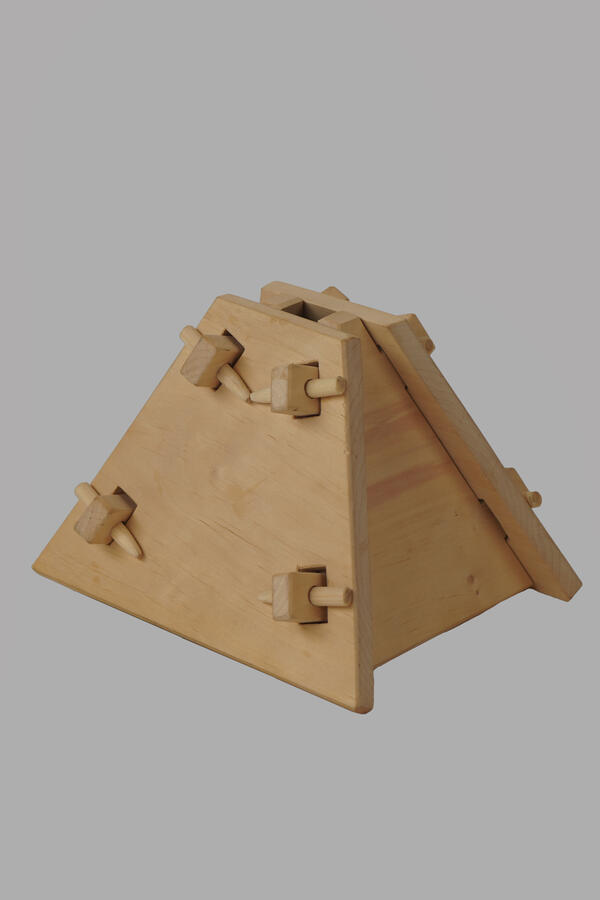Easter is considered the most significant celebration of the Orthodox Christian church. Three dishes traditionally served at the Easter meal are Easter cakes, colored eggs and Easter cottage cheese. All of them are prepared only once a year since they carry a deep sacred meaning, and people enjoy them only during the Easter Week.
Paskha dessert, a sweet curd cheese, symbolizes the manna from heaven, which the Lord bestowed on the chosen people. The shape of the dessert — a high truncated pyramid — has two explanations. First, it symbolizes the church. Secondly, it is the image of Calvary, the hill where, according to the New Testament, Jesus Christ was crucified.
Until the 18th century, Easter cheese was a thick mass of fermented milk, and so it was called “thickened milk”. Later, when homemakers began to use hard cottage cheese, the first wooden Easter cheese molds appeared. They were needed to give shape to the soft dessert.
There were solid metal cheese molds, but more often —wooden ones consisting of separate parts. Only the wood of deciduous trees was used. Trapezoidal planks were cut from linden, birch, beech or alder wood. Two of them were made with “ears”, and the other two — with protrusions, so that the planks could be fixed together. The bottom and top of the pyramid were made a little smaller so that excess liquid could drain through. Additionally, the structure was fastened with wedges.
The inner side of the planks was decorated with carvings: the obligatory letters “ХВ” (Christ is Risen), and images of the cross. Other Christian motifs and floral patterns could also be used. A dove symbolized the Holy Spirit, a sailboat — Noah’s Ark or a church, a vine with seven berries — the seven Church Sacraments, a green bush — the Burning Bush, a branch with fruit — the Paradise Tree of Life, and a ladder was one of the symbols of the Virgin.
Traditionally, the treat was prepared on Maundy Thursday, after praying and thoroughly washing hands. Thus, the cheese was ready in time for Easter. The cheese mold was rinsed with spring water and dried; then some gauze or other thin fabric was put inside. After that it was filled with a sweet mass of cottage cheese, which was ground with butter, eggs, sour cream and cream and flavored with almonds, candied fruits, spices, and raisins. The form was tied with a hemp rope and put in the cold under oppression. Before serving, the gauze was removed, and the Easter cottage cheese was turned over onto a dish. On top it was often crowned with a sugar cross or a festive red candle.
After Easter cheese molds were put away until next year. For safety, they were washed, greased with linseed oil and wrapped in cloth. This kitchen utensil was especially treasured as a family heirloom.
Paskha dessert, a sweet curd cheese, symbolizes the manna from heaven, which the Lord bestowed on the chosen people. The shape of the dessert — a high truncated pyramid — has two explanations. First, it symbolizes the church. Secondly, it is the image of Calvary, the hill where, according to the New Testament, Jesus Christ was crucified.
Until the 18th century, Easter cheese was a thick mass of fermented milk, and so it was called “thickened milk”. Later, when homemakers began to use hard cottage cheese, the first wooden Easter cheese molds appeared. They were needed to give shape to the soft dessert.
There were solid metal cheese molds, but more often —wooden ones consisting of separate parts. Only the wood of deciduous trees was used. Trapezoidal planks were cut from linden, birch, beech or alder wood. Two of them were made with “ears”, and the other two — with protrusions, so that the planks could be fixed together. The bottom and top of the pyramid were made a little smaller so that excess liquid could drain through. Additionally, the structure was fastened with wedges.
The inner side of the planks was decorated with carvings: the obligatory letters “ХВ” (Christ is Risen), and images of the cross. Other Christian motifs and floral patterns could also be used. A dove symbolized the Holy Spirit, a sailboat — Noah’s Ark or a church, a vine with seven berries — the seven Church Sacraments, a green bush — the Burning Bush, a branch with fruit — the Paradise Tree of Life, and a ladder was one of the symbols of the Virgin.
Traditionally, the treat was prepared on Maundy Thursday, after praying and thoroughly washing hands. Thus, the cheese was ready in time for Easter. The cheese mold was rinsed with spring water and dried; then some gauze or other thin fabric was put inside. After that it was filled with a sweet mass of cottage cheese, which was ground with butter, eggs, sour cream and cream and flavored with almonds, candied fruits, spices, and raisins. The form was tied with a hemp rope and put in the cold under oppression. Before serving, the gauze was removed, and the Easter cottage cheese was turned over onto a dish. On top it was often crowned with a sugar cross or a festive red candle.
After Easter cheese molds were put away until next year. For safety, they were washed, greased with linseed oil and wrapped in cloth. This kitchen utensil was especially treasured as a family heirloom.






